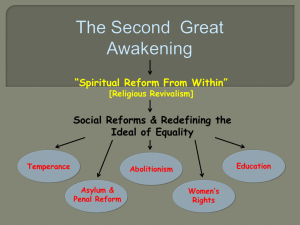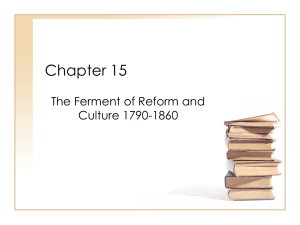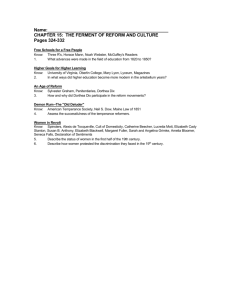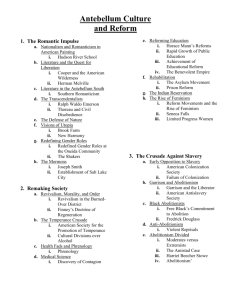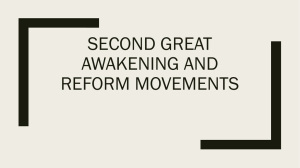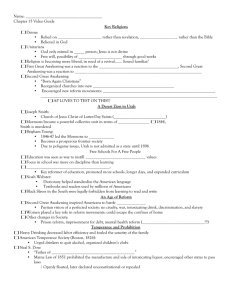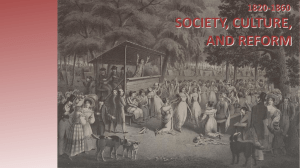Age of Reform (Temperance, Prison/Asylum
advertisement
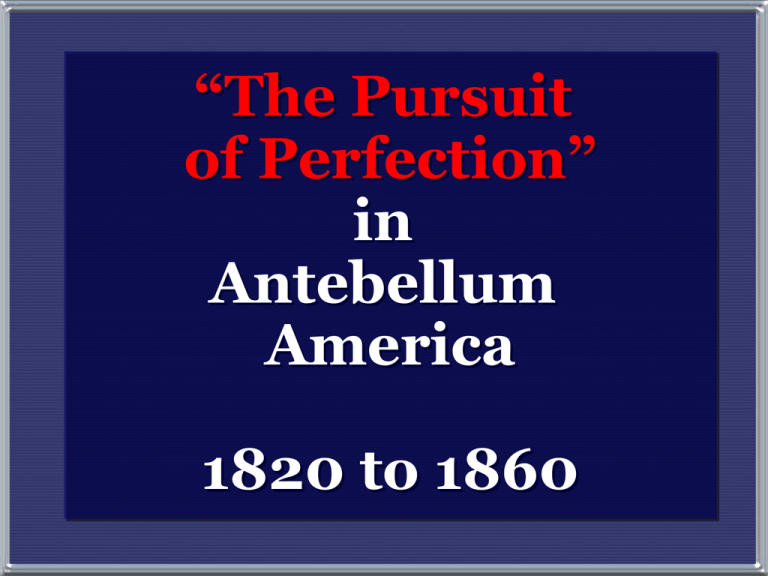
“The Pursuit of Perfection” in Antebellum America 1820 to 1860 The Age of Reform • Reasons: – The Great Awakening sparked interest that the individual could control their destiny and that “good deeds” will make the nation a better place – The middle-class feel that they should be models of behavior for the “unmannered and ill-behaved” – Finally, women are driving forces for reform because they are no longer kept at home and now have a voice (predominantly in the church) 1. Ante-Bellum—1820 to 1860 • Romantic age • Reformers pointed out the inequality in society • Industrialization vs. progress in human rights • Primarily a Northern movement • Southerners refused reforms to protect slavery • Educated society through • newspaper and lyceum meetings • Areas to reform: Slavery women’s rights Industrialization public school Male domination temperance (alcohol) War prison reform 2. 2nd Great Awakening---1820’s to 1840’s •religious revival vs. deists •Rise of Unitarians---believed in a God of love •Denied the trinity •heaven through good works and helping others •social conscience = social gospel •apply Christ’s teachings to bettering society •Contrasted with salvation by grace and getting to heaven through Christ • Baptists, Methodists, etc. 3. Formed utopian societies = collective ownership The Second Great Awakening “Spiritual Reform From Within” [Religious Revivalism] Social Reforms & Redefining the Ideal of Equality Temperance Education Abolitionism Asylum & Prison Reform Women’s Rights The Temperance Movement • In 1830, Americans drink an average of 5 gallons of liquor a year • Reformers argue that drinking causes domestic violence, public rowdiness and loss of family income • The real problem is Americans have the habit of drinking all day Temperance Movement • The most significant reform movements of the period sought not to withdraw from society but to change it directly • Temperance Movement — undertook to eliminate social problems by curbing drinking – Led largely by clergy, the movement at first focused on drunkenness and did not oppose moderate drinking – In 1826 the American Temperance Society was founded, taking voluntary abstinence as its goal. •Lyman Beecher •Neal Dow •Lucretia Mott •Anti-Alcohol movement •American Temperance Society formed at Boston-----1826 • sign pledges, pamphlets, anti-alcohol tract 10 nights in a Barroom and What I Saw There •“Demon Drink” adopt 2 major lines of attack: •stressed temperance and individual will to resist The Temperance Movement • Movement became popular, but interrupted by the approaching Civil War. • It eventually picked up again, and led to the 18th Amendment The Second Great Awakening “Spiritual Reform From Within” [Religious Revivalism] Social Reforms & Redefining the Ideal of Equality Temperance Education Abolitionism Asylum & Prison Reform Women’s Rights The Asylum Movement (orphanages, jails, hospitals) • Asylums isolated and separated the criminal, the insane, the ill, and the dependent from outside society • “Rehabilitation” – The goal of care in asylums, which had focused on confinement, shifted to the reform of personal character The Asylum Movement • Dorothea Dix, a Boston schoolteacher, took the lead in advocating state supported asylums for the mentally ill • She attracted much attention to the movement by her report detailing the horrors to which the mentally ill were subjected – being chained, kept in cages and closets, and beaten with rods • In response to her efforts, 28 states maintained mental institutions by 1860 Asylums and Prison Reform • Dorothea Dix also discovered that people were placed in prisons for debt, people were subjected to cruel punishment and children were not treated any different than adults • She is responsible for helping eliminate sentencing for debt, ending cruel punishment and getting states to establish juvenile court systems • She argues that people can change if they are placed in proper environments and given an education The Second Great Awakening “Spiritual Reform From Within” [Religious Revivalism] Social Reforms & Redefining the Ideal of Equality Temperance Education Abolitionism Asylum & Prison Reform Women’s Rights Educational Reform In 1800 Massachusetts was the only state requiring free public schools supported by community funds Middle-class reformers called for tax-supported education, arguing to business leaders that the new economic order needed educated workers Educational Reform Under Horace Mann’s leadership in the 1830s, Massachusetts created a state board of education and adopted a minimumlength school year. Provided for training of teachers, and expanded the curriculum to include subjects such as history and geography Educational Reform By the 1850s the number of schools, attendance figures, and school budgets had all increased sharply School reformers enjoyed their greatest success in the Northeast and the least in the South Southern planters opposed paying taxes to educate poorer white children Educational opportunities for women also expanded In 1833 Oberlin College in Ohio became the first coeducational college. Four years later the first all-female college was founded — Mount Holyoke, Massachusetts Education for African-Americans Public Schools in the North did not accept black students to the same schools as white students (some exceptions). Southern states made educating slaves illegal; anyone caught teaching them to read was arrested. Massachusetts was the first state to accept black students Private colleges like Harvard, accepted black students. Black colleges also started forming Women Educators Troy, NY Female Seminary curriculum: math, physics, history, geography. train female teachers Emma Willard (1787-1870) 1837 she established Mt. Holyoke [So. Hadley, MA] as the first college for women. Mary Lyons (1797-1849)
